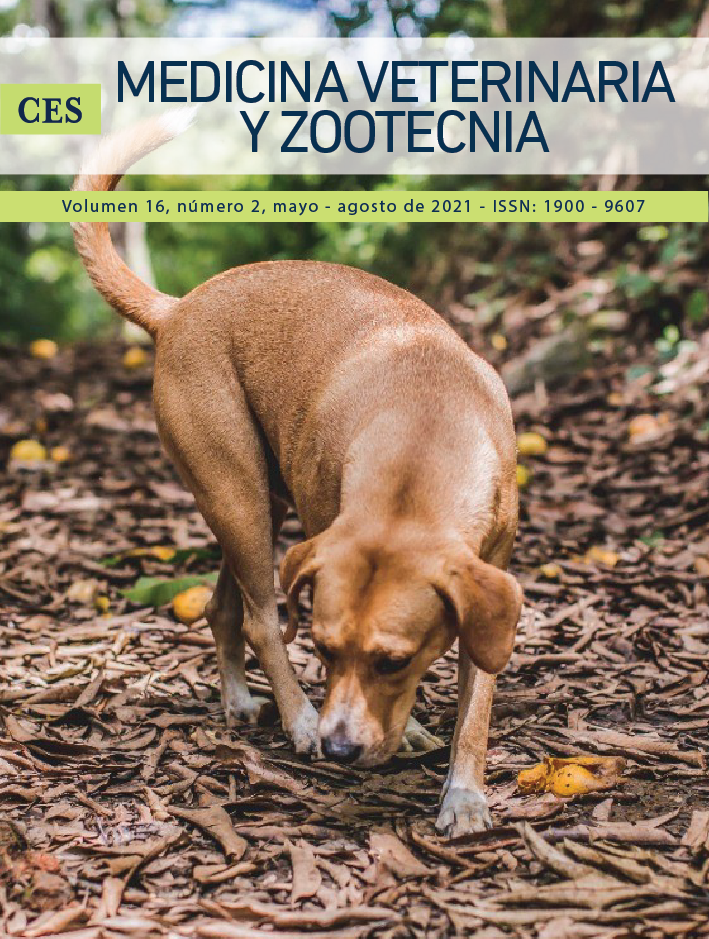Cystatin C as a gold standard biomarker for the acute kidney disease diagnosis in canines
DOI:
https://doi.org/10.21615/cesmvz.6439Keywords:
biomarker, canine, cystatin C, disease, filtrationAbstract
Canines with kidney lesions are affected by different processes such as filtration, reabsorption and excretion that alter homeostasis. The measurement of alternative biomarkers has served for the diagnosis and prognosis of kidney damage, which has served the veterinarian, not only for the opportunity in early diagnosis but also for preventive exercise. One of the markers that allows evaluating the glomerular filtration rate (GFR) is the serum concentration of creatinine, since it varies in inverse proportions, on the other hand there is creatinine (Ccr), being a good tool to indicate the commitment of glomerular function, although this is not usually so reliable, due to its high interferences at the time of measurement. For this reason, other biomarkers have been postulated that give an earlier prognosis and that allow timely treatment, among them is cystatin C, which has low interindividual variability, since it does not generate protein junctions, does not have tubular secretion, is not generated tubular reabsorption if there is no protein catabolism. The objective of this review is to present Cystatin C (CisC) as a gold standard biomarker for the diagnosis of acute kidney problems in canines, since in human medicine it has already been established that CisC has a better renal diagnostic and determination value. of GFR than serum creatinine. The characteristics that lead this protein to be an excellent renal biomarker is due to the fact that it has a constant production and plasma concentration in situations of absence of GFR variations. To collect the information used in this review, various sources were used such as: PubMed, Scielo, Journal of Small Animal Practice, National Center for Biotechnology Information, where 50 articles were selected to carry out this research.
Downloads
References
Cobrin A, Abrams A, Dewey C, Kruth S, Blois S. Biomarkers in the assessment of acute and chronic kidney diseases in the dog and cat. J Small Anim Pract 2013; (54): 647-655.
Loor J, Daminet S, Smets P, Meyer E, Maddens B. Biomarcadores urinarios para la lesión renal aguda en perros. J Vet Intern Med 2013; 27 (5): 998-1010.
Ferguson M, Vaidya V, Bonventre J. Biomarkers of Nephrotoxic Acute Kidney Injury. NCBI 2008; 245 (3): 182–193.
Navarro Combalía L. Estudio de nuevos marcadores en el diagnóstico de la enfermedad renal en el perro. Tesis doctoral, Universidad de Zaragoza, 2013. 93 p.
Rey J, Caparrós E. Revisión: Biomarcadores precoces de lesión renal aguda en Medicina Veterinaria. Rhv.cl 2017; 15-21.
Nishiib N, Iwasa N, Takashimab S, Iwasa T, Iwasa K, et al. Serum cystatin C concentration measured routinely is a prognostic marker for renal disease in dogs. Res Vet Sci 2018; 119: 122-126.
Ferguson T, Komenda P, Tangri N. Cystatin C as a Biomarker for Estimating Glomerular Filtration Rate. PubMed 2015; 24 (3): 295-300.
Iwasa N, Takashima S, Iwasa T, Nishii N. Evaluation of Monitoring Methods in Asymptomatic Dogs With High Serum Cystatin C Concentrations. PubMed 2019; 81 (12): 1730-1734.
Von V, Pressler B. An Overview of Glomerular Filtration Rate Testing in Dogs and Cats. NCBI 2010; 188 (2): 156–165.
Marynissen J, Pascale M, Liesbeth F, Delanghe J, Galac S, Meyer E, et al. Long-term follow-up of renal function assessing serum cystatin C in dogs with diabetes mellitus or hyperadrenocorticism. PubMed 2016; 45 (2): 9-20.
Rosas Arango S, Almonacid C. Utilidad de biomarcadores de perfil renal para el diagnóstico de enfermedad renal en caninos. Diario de campo 2015; (8): 43-53.
Pelander L, Häggström J, Larsson A. Comparison of the Diagnostic Value of Symmetric Dimethylarginine, Cystatin C, and Creatinine for Detection of Decreased Glomerular Filtration Rate in Dogs. PubMed 2019; 33 (2): 630-639.
Liu D, Meyer E, Broeckx B. Variability of Serum Concentrations of Cystatin C and Urinary Retinol-Binding Protein, Neutrophil Gelatinase-Associated Lipocalin, Immunoglobulin G, and C-reactive Protein in Dogs. PubMed 2019; 32 (5): 1659-1664.
Steinbach S, Weis J, Schweighauser A, Francey T, Neiger R. Plasma and Urine Neutrophil Gelatinase-Associated Lipocalin (NGAL) in Dogs with Acute Kidney Injury or Chronic Kidney Disease. J Vet Intern Med 2016; 28 (2): 264-269.
Cowgill L, Polzin D, Elliott J, Nabity M, Segev G,et al. Is Progressive Chronic Kidney Disease a Slow Acute Kidney Injury?. Vet Clin Small Anim 2016; 46 (6): 995-1013.
Fernandez C, Arraque C, Mendez J, Angulo L, Fargier F. Manejo renal de la ß2 microglobulina. Su significado en portadores de la nefronoptisis del adolescente.Scielo 2007; 48 (2): 139-145.
Lengua D. Evaluación de la utilidad clínica del marcador SDMA dimetil arginina. Tesis de pregrado, Facultad de Veterinaria, Universidad Zaragoza, 2017. 33 p.
Filler G, Bokenkamp A, Hofmann W, Le Bricon T, Martinez Brú C,et al. Cystatin C as a Marker; of GFR--history, Indications, and Future Research.PubMed 2005; 38 (1): 1-8.
Arrebola M, Carrasco J. Nuevos biomarcadores de insuficiencia renal aguda. Educación continuada en el laboratorio clínico (2012). https://www.seqc.es/download/tema/7/3315/3778230/267174/cms/tema-4-biomarcadores-de-insuficiencia-reanal-aguda.pdf/.
Gallar P, Vigil Medina A, Oliet Palá A. Cistatina C, ¿algo más que la estimación del filtrado glomerular? ELSEVIER 2013; 30 (2): 58-69.
Almy F, King D, Brown S. Evaluation of Cystatin C as an Endogenous Marker of Glomerular Filtration Rate in Dogs. J Vet Intern Med 2002; 16 (1): 45-51.
Dharnidharka V, Kwon C, Stevens G. Serum Cystatin C Is Superior to Serum Creatinine as a Marker of Kidney Function: A Meta-Analysis. PubMed 2002; 40 (2): 6-221.
Stevens L, Schmid C, Greene T. Factors Other Than Glomerular Filtration Rate Affect Serum Cystatin C Levels. PubMed 2008; 75 (6): 60-80.
Hirschberger J, Wehner A, Hartmann K. Utility of Serum Cystatin C as a Clinical Measure of Renal Function in Dogs [Internet]. J Am Anim Hosp Assoc 2008; (3): 1-2.
Pagitz M, Frommlet F, Schwendenwein I. Evaluation of Biological Variance of Cystatin C in Comparison With Other Endogenous Markers of Glomerular Filtration Rate in Healthy Dogs. PubMed 2007; 21 (5): 42-50.
Zahran A, El-Husseini A, Shoker A. Can Cystatin C Replace Creatinine to Estimate Glomerular Filtration Rate? A Literature Review. PubMed 2007; 27 (2): 197-205.
Bostom A, Dworkin L. Cystatin C measurement: Improved detection of mild decrements in glomerular filtration rate versus creatinine-based estimates?. PubMed 2000; 36 (1): 205-207.
Ventura S, Cárdenas Fernández M, García M, Coll E, Bermudo C, Cortés M et al. Cistatina C en la evaluación de la función renal. Rev Lab Clin 2011; 4 (1): 50-62.
Abdel-Razek W, Mahmoud O, Abo-Raia G, Assem M, El-Azab G. Evaluation of Serum Cystatin C as a Marker of Early Renal Impairment in Patients with Liver Cirrhosis. Int J Hepatol 2015; (2015): 30-90.
Ghys L, Daminet S, Delanghe J, Lefebvre H, Smets P,et al. Cystatin C: A New Renal Marker and Its Potential Use in Small Animal Medicine . J Vet Intern Med 2014; (4): 1152–1164.
Villagra D. Aplicación de la imagenología a la clínica del aparato urogenital canino. Tesis de pregrado. Facultad de Veterinaria, Universidad de León. 2017; 216 p.
Aparato circulatorio y excretor. [Image]. citado el 27 de abril de 2021. Disponible en: http://recursos.cnice.mec.es/biosfera/alumno/3ESO/aparato_circulatorio/contenidos10.htm
Gustavo Ramón S. Sistema renal y actividad física, Conocimiento corporal. IV Apuntes de Clase. Viref; 7-11.
Wikipedia. Fisiología de la nefrona. (2016). [Image]. citado el 27 de abril de 2021. Disponible en: https://es.wikipedia.org/wiki/Sistema_urinario_humano#/media/Archivo:Physiologyof_Nephron_es.svg
Leon Martínez M. Insuficiencia renal su concepto, clasificación, síntomas y repercusiones en el cuerpo de los animales domésticos. Tesis doctoral, Universidad Técnica de Machala,2019. 57 p.
Sabbatini M, Paludi A, Castro E. Insuficiencia renal aguda: un diagnóstico precoz para una resolución exitosa. UNICEN 2017; 15-26.
Asociación Protectora de Animales y Plantas de Burgos. Problemas renales en perros y gatos y su tratamiento [Internet]. [citado el 21 de abril de 2021]. Disponible en: http://protectoraburgos.es/problemas-renales-en-perros-y-gatos-y-su-tratamiento/
González Castillo L, Sanmiguel Plazas R. Acercamiento a la enfermedad renal crónica en caninos y felinos geriátricos. Rev .uptc 2018; 15 (2): 71-81.
Pibot P, Biourge V, Elliott D. Insuficiencia renal crónica: importancia de la nutrición. Ivis.org. 2008; 2: 20-130.
Berlato D, Benchekroun G, Archer J, Monti P. Initial evaluation of canine urinary cystatin C as a marker of renal tubular function. J Small Anim Pract 2012; (53): 254–259.
González Borges D, Benavides A, Rodríguez Jiménez Y, Hernandez Palet I, Martinez I, et al. Use of Cystatin C Biomarker in Patients with Possible Renal Failure. Rev finlay. 2020; 9 (4): 1-7.
Castellanos R, Vidalita T, Luigi M et al. Influencia de la masa corporal sobre la concentración sérica de creatinina en perros adultos de la parroquia de San José, municipio de Valencia, edo, Carabobo, Venezuela. Revista Científica, FCV-LUZ / Vol. XIX, Nº 1, (2009): 25 - 30.
Lees GE. Early diagnosis of renal disease and renal failure. Pubmed 2004; 34 (4): 85-115.
Antognoni M, Siepi D, Porciello F, Fruganti G. Use of serum cistatin C determination as a marker of renal function in the dog.Vet Res Commun 2005; 29 (2): 265-267.
Braun J, Perxachs A, Pe’Chereauf D, De La Farge F. Plasma Cystatin C in the dog:, reference values and variations with renal failure. Comp Clin Path 2002; 11: 44-49.
Miyagawa Y, Takemura N, Hirose H. Evaluation of the Measurement of Serum Cystatin C by an Enzyme-Linked Immunosorbent Assay for Humans as a Marker of the Glomerular Filtration Rate in Dogs.J Vet Med Sci 2009; 71 (9): 76-100.
Knight E, Verhave J, Spiegelman D, Hillege H, De Zeeuw D, et al. Factors Influencing Serum Cystatin C Levels Other Than Renal Function and the Impact on Renal Function Measurement. ELSEVIER 2004;65(4):21-40.
Castaño Bilbao I, Slon Roblero F, Garcia Fernandez N. Estudios de función renal: función glomerular y tubular. Análisis de la orina . NefroPlus 2009; 2 (1): 1-62.
Ferguson M, Waikar S. Established and Emerging Markers of Kidney Function.Clin Chem 2012; 58 (4): 680–689.
Newman D, Thakkar H, Edwards R, Wilkie M, White T, Grubb A et al. Serum cystatin C measured by automated immunoassay: A more. sensitive marker of changes in GFR than serum creatinine Kidney International 1995; (47): 312-318.
Martínez Méndez P, Martínez Padua I, Martínez Padua P. Caracterización de la función renal en perros. Scielo 2012; (23): 73-82.
Ramírez L, Albarracín L, Castillo D, Bueno J, Aguilera A. Cystatin C vs conventional markers of renal function: an update. SaludUninorte 2019; 35 (1): 110-123.
53 Finney H, Newman D, Gruber W, Merle P, Price C. Initial Evaluation of Cystatin C Measurement by Particle-Enhanced Immunonephelometry on the Behring Nephelometer Systems (BNA, BN II). Clin Chem 1997; 43 (6 Pt 1): 22-90.
Jonkisz P, Kungl K, Sikorska A. Cystatin C Analysis in the Dog: A Comparison of Turbidimetric and Nephelometric Assay Results. PubMed 2010; 58 (1): 59-67.
55 Jensen A, Bomholt M, Moe L. Preliminary Evaluation of a Particle-enhanced Turbidimetric Immunoassay (PETIA) for the Determination of Serum Cystatin C-Like Immunoreactivity in Dogs. J Vet Med Sci 2008; (30): 86-90.
Downloads
Published
How to Cite
Issue
Section
License
Copyright (c) 2021 CES Medicina Veterinaria y Zootecnia

This work is licensed under a Creative Commons Attribution-NonCommercial-ShareAlike 4.0 International License.
| Article metrics | |
|---|---|
| Abstract views | |
| Galley vies | |
| PDF Views | |
| HTML views | |
| Other views | |



